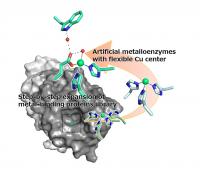Content is provided by our community of institutions, partners, researchers and journalists.
Newcastle University in Singapore
02 Apr 2023
An international team of scientists is helping to reduce carbon emissions into the atmosphere by exploring different natural fibres and blending the natural fibres in plastics to make light-weight and strong green composite materials for the construction and automotive industries.
Asia Research News
31 Mar 2023
Asia Research News monitors the latest research news in Asia. Some highlights that caught our attention this week are glowing worms named after ghosts, bacteria that can create plastic from thin air, and a water source on the moon.
Tohoku University
31 Mar 2023
Asexual, or vegetative, reproduction in plants is controlled by environmental conditions, but the molecular signaling pathways that control this process are poorly understood. Recent research suggests that the KAI2-ligand (KL) hormone is responsible for initiating and terminating the production of gemmae, or genetically identical plantlets, on liverwort plants based on the presence or absence of specific environmental factors.
Daegu Gyeongbuk Institute of Science and Technology (DGIST)
31 Mar 2023
- Researcher startup MFR and student startup TIA have been selected among five innovative startups in the region
- Startups will receive funds up to 100 million KRW for one year and the opportunity to collaborate with Samsung Electronics and its affiliates
Daegu Gyeongbuk Institute of Science and Technology (DGIST)
31 Mar 2023
- Successful localization of magnetic sensor chips through a performance evaluation based on unique technologies of DGIST (original technology), Electric Vehicle Advanced Materials Co., Ltd. (module mass production), and Kwangwoo Co., Ltd. (product production)
- Expected to strengthen national competitiveness in the global sensor market, which is dominated by foreign companies based on performance and price competitiveness
Daegu Gyeongbuk Institute of Science and Technology (DGIST)
31 Mar 2023
- The effect of the cycle of G proteins in real time on the two-step structural change of cell membrane receptors has been investigated
- This study is expected to be applied to pathologies related to G protein-coupled receptors and on research for their treatments
Daegu Gyeongbuk Institute of Science and Technology (DGIST)
31 Mar 2023
- The 2021 paper from the research team of Professor Dongwon Yoon of the Daegu Gyeongbuk Institute of Science & Technology (DGIST) was selected as the cover paper for the 10th anniversary edition of the top Soft Robotics Journal
- Recognized for excellence in robot hand technology that is as flexible and delicate as a human hand combined with a “flexure hinge”
Daegu Gyeongbuk Institute of Science and Technology (DGIST)
31 Mar 2023
- Development of low-temperature, highly graphitized carbon synthesizing method that can overcome the limitations of existing fuel-cell carbon supports
- Expected to be used in next-generation fuel-cell vehicles with improved generation efficiency and excellent stability
- Study results will be published in ‘Applied Catalysis B: Environmental’, a top journal in the field of Environmental Science
Daegu Gyeongbuk Institute of Science and Technology (DGIST)
31 Mar 2023
- DGIST student startups, CURE and TIA, proved the possibility of commercialization and investment attraction of their next-generation eco-friendly technology
Daegu Gyeongbuk Institute of Science and Technology (DGIST)
31 Mar 2023
- Research teams led by Professor Hongsoo Choi and Professor Yongseok Oh from DGIST joined the research team led by Dr. Jongcheol Rah from Korea Brain Research Institute to develop the technology for delivering a microrobot to a target point of a hippocampus in an in-vitro environment, connecting neural networks, and measuring neural signals
- The research findings are expected to contribute to neural network research and the verification and analysis of cell therapy products
Daegu Gyeongbuk Institute of Science and Technology (DGIST)
31 Mar 2023
- DGIST Professor Minseok Kim’s research team has developed an electronic medicine that can restore normal Schwann cell phenotypes in CMT disease models
- It presents the potential of electric stimulation-based treatment for chronic peripheral nerve disorders
Daegu Gyeongbuk Institute of Science and Technology (DGIST)
31 Mar 2023
A total of 242 students (29 Ph.D., 87 master’s, and 126 bachelor’s) graduated in science and technology fields
Daegu Gyeongbuk Institute of Science and Technology (DGIST)
31 Mar 2023
- The world’s first technology for synthesizing high-quality and low-cost copper-graphene nanowire using intense scintillation
- Implementation of high-performance transparent-flexible electronic device based on copper-graphene nanowire and publication in the international journal Nano Energy, which is renowned in the field of energy
Daegu Gyeongbuk Institute of Science and Technology (DGIST)
31 Mar 2023
Lays the groundwork to host the National Aerospace Science Competition in H2 of 2023
Osaka Metropolitan University
30 Mar 2023
Researchers from Osaka Metropolitan University Graduate School of Medicine conducted an interoperative comparison of lateral disc meniscus injuries of young patients (aged 15 or less), that were treated with plastic sutures or subtotal resection, to see if there was a difference in postoperative cartilage degeneration. The research group observed that sub-total meniscectomies were more likely to show cartilage degeneration, being worst in lateral disc meniscus injuries. In addition, they found that even with higher levels of meniscus damage, preserving the meniscus with sutures was more effective in protecting the cartilage in young patients.
Osaka Metropolitan University
30 Mar 2023
Osaka Metropolitan University scientists have developed a process using artificial photosynthesis to successfully convert more than 60% of waste acetone into 3-hydroxybutyrate, a material used to manufacture biodegradable plastic. The results were obtained using low-concentration CO2, equivalent to exhaust gas, and powered by light equivalent to sunlight for 24 hours. The researchers expect that this innovative way of producing biodegradable plastic could not only reduce CO2 emissions but also provide a way of reusing laboratory and industrial waste acetone.
Kanazawa University
29 Mar 2023
Researchers at Kanazawa University report in JACS Au how they have developed operando scanning ion conductance microscopy to allow simultaneous measurements of changes in the anode surface topography of a lithium ion battery during use, as well as the varying ion concentration with depth. Combining both types of information should help researchers evaluate the correlation between the two to design better batteries.
Osaka Metropolitan University
29 Mar 2023
A research group at Osaka Metropolitan University has succeeded in simply creating an artificial metalloenzyme with the common metal-binding motif 2-his-1-carboxylate, which is found in natural non-heme metalloenzymes. They created a library of 12 different proteins and screened the library and found that the H52A/H58E variant had the best stereoselectivity. It is expected that this research can be expanded to produce a variety of biocatalysts that work under mild conditions.
Osaka Metropolitan University
29 Mar 2023
A group including Osaka Metropolitan University researchers discovered that the rhodopsin—a protein in the eye that detects light—of whale sharks has changed to efficiently detect blue light, which penetrates deep-sea water easily. The amino acid substitutions–one of which is counterintuitively associated with congenital stationary night blindness in humans—aid in detecting the low levels of light in the deep-sea. Although these changes make the whale shark rhodopsin less thermally stable the deep-sea temperature, allows their rhodopsin to keep working. This suggests that the unique adaptation evolved to function in the low-light low-temperature environment where whale sharks live.
Osaka Metropolitan University
28 Mar 2023
Cancer-associated fibroblasts (CAFs) are key factors in the tumor microenvironment, which have been implicated in cancer cell progression. It has also been reported that vesicles called exosomes produced by these CAFs play an important role in cancer progression. An Osaka Metropolitan University research group investigated the effect of CAF-derived exosomes on the growth of malignant melanoma cells. They found that CAF-derived exosomes express CD9 and CD63 transmembrane proteins, and that the CD9-positive exosomes may inhibit the growth of malignant melanoma cells.
Duke-NUS Medical School
28 Mar 2023
· Duke-NUS sleep scientists’ analyses show associations between early classes, less sleep, poor attendance and reduced grade point average.
· Studies in secondary and junior college students have shown that later start times can have positive impacts on grades.
Lingnan University (LU)
28 Mar 2023
Lingnan University (LU) kickstarted their Bug Wars against Food Waste Project on 27 March in order to both reduce food waste and turn it into a useful asset. The campaign aims to inspire students, faculty members and the whole community to adopt a low-carbon lifestyle, using black soldier flies to convert food waste collected from student hostels and canteens into organic fertiliser for the Lingnan Gardeners Project and plants on the campus, as well as quality feed for campus animals. Staff, students and the elderly are signing up as low-carbon ambassadors to develop and apply innovative ideas to resolve community issues and promote a more sustainable lifestyle.
Osaka Metropolitan University
27 Mar 2023
An Osaka Metropolitan University joint research group has discovered that near-infrared absorbing dyes, which had previously been considered to have closed-shell electronic structures, have an intermediate electronic structure, between closed- and open-shell structures. They also found that as the wavelength of near-infrared light that can be absorbed becomes longer the contribution of open-shell forms increases within the dye. These newly discovered characteristics are expected to be utilized to develop new near-infrared absorbing dyes that can absorb longer wavelength near-infrared light.
Osaka University
27 Mar 2023
Researchers from Osaka University have found that repeated high-dose treatment, known as pulse therapy, with the steroid methylprednisolone reduces in-hospital deaths in COVID-19 patients who receive invasive mechanical ventilation, but not in patients who don’t receive invasive mechanical ventilation. These findings were only possible using appropriate statistical methods to remove bias from the data, which originally seemed to show that the opposite was true. These results can improve patient treatment and reduce COVID-19-related deaths worldwide.
MAP Academy
26 Mar 2023
These figurines from more than 4000 years ago, provide insights into the material culture of one of the oldest Bronze Age Civilizations, the Indus Valley Civilization.
Asia Research News
24 Mar 2023
Asia Research News monitors the latest research news in Asia. Some highlights that caught our attention this week are how we are losing tribal languages, how living next to a road raises your blood pressure, and a flower hiding in plain sight.
Tohoku University
24 Mar 2023
Hailey-Hailey disease is a rare, inherited condition characterized by patches of blisters appearing mainly in the skin folds of the arm pits, groin and under the breasts. It is caused by a mutation in the gene that codes for a specific protein. Tohoku University scientists have uncovered some critical details of this protein’s structure, and the findings could build the foundation for developing treatment for Hailey-Hailey disease and other neurodegenerative conditions.
Osaka Metropolitan University
24 Mar 2023
A research group from Osaka Metropolitan University investigated the relationship between tobacco use, including heated tobacco products, with the risk of SARS-CoV-2 infection and severe COVID-19. The researchers administered an online survey of living conditions in February 2022 to 30,130 participants aged 16-81 years, finding that heated tobacco product users had significantly higher rates of SARS-CoV-2 infection compared to non-tobacco users. Furthermore, the research group found that among all tobacco users, those who used both heated tobacco products and traditional cigarettes had the highest incidence of requiring hospitalization or oxygen due to COVID-19.
Nanyang Technological University
24 Mar 2023
Scientists in Singapore converted fruit waste into a solar absorber called Mxene to develop an efficient and sustainable water desalination process.
Kavli Institute for the Physics and Mathematics of the Universe (Kavli IPMU)
23 Mar 2023
Machine learning and state-of-the-art supernova nucleosynthesis has helped researchers find that the majority of observed second-generation stars in the universe were enriched by multiple supernovae.




























